| THE DRESDEN LINES The city of Dresden is about 100 miles south of Berlin, my favourite gateway into Germany. The autobahn goes directly from Berlin Schonefeld airport to the outskirts of Dresden meaning that the keen photographer can be at the lineside within two hours of landing. Three working narrow gauge lines are to be found in the Dresden area. These are the liners from Frietal - Kipsdorf, Radebeul Ost - Radeburg and Cranzahl - Oberwiesentahl. All three are 750mm gauge lines, branching off from the main DB system. FRIETAL - KIPSDORF In 2002 the Frietal - Kipsdorf railway was badly damaged by major flooding, which severely damaged much of the track and infrastructure. The damage was estimated to be around 20 million euros and a fund-raising campaign was organised. The Federal government and the Government of Saxony agreed to cover half of what wass needed to rebuild the railway line and reconstruction officially started on September 14, 2004. The section of line between Freital-Hainsberg station and Dippoldiswalde, the normal passing point for trains, was reopened on 14 December 2008. Six return trains per day are normally operated on this section. The section of line from Dippoldiswalde to the terminus at Kurort Kipsdorf is due to reopen in 2010. All three lines are in the hands of private companies and cut backs to services have been made as the new owners struggle to balance the books. Each line merits at least two days to explore and enjoy and there are plenty of photographic opportunities. Car chasing is possible but please respect local sensibilities and beware of police with radar guns! |
| The line from Frietal Hainsberg to Kipsdorf is now known as the Weisseritztahlbahn, and when fully open is just under 27km long and worked almost exclusively by 2-10-2T locomotives. Prior to the temporary closure there were 7 return trips a day and three locomotives are normally required to operate the service. The 16 mile journey takes a staggering 90 minutes which may go some way to explaining the steady loss of passengers to road transport! Locomotives work smokebox first from Frietal and there are no turning facilities at Kipsdorf. The line climbs through the delightful gorge at Rabenau and skirts a large lake near Malter before reaching the half-way station at Dippoldeswalde. From here the line climbs more steeply, crossing the spectacular viaduct at Schmiedeberg and eventually arriving in the massive terminus at Kipsdorf - possibly the largest narrow-gauge terminus in Germany. |
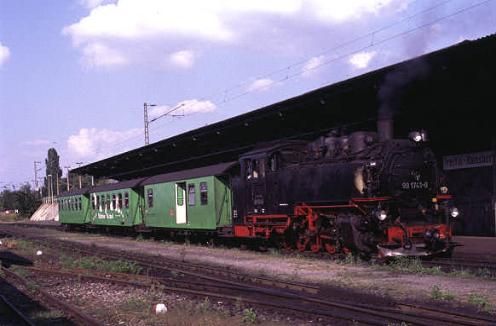
| No.99-1741 stands at the head of the 17.00 train in Freital-Hainsberg station in July 2000 (upper left) No 99-1746 brings a morning train alongside a farm track between Seifersdorf and Malter (lower left) The gorge at Rabenau offers some spectacular scenery but timing and a low water level are essential to avoid heavy shadows and wet feet as No.99-1746 heads towards Dippoldeswald (right) |
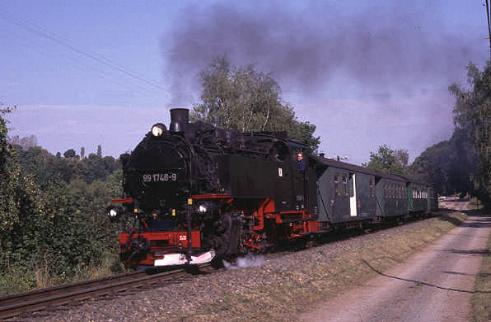
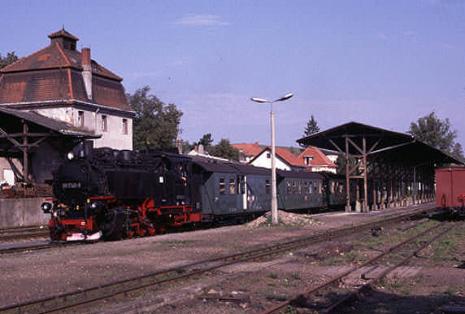
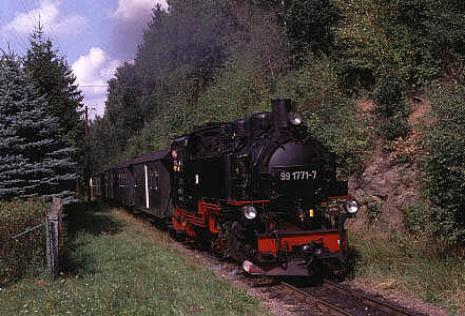
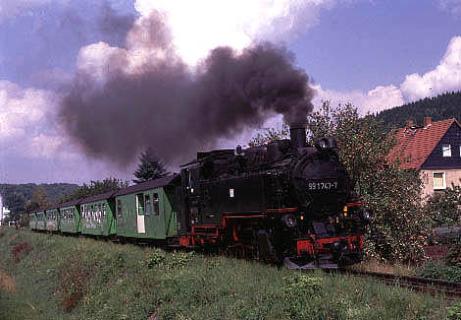
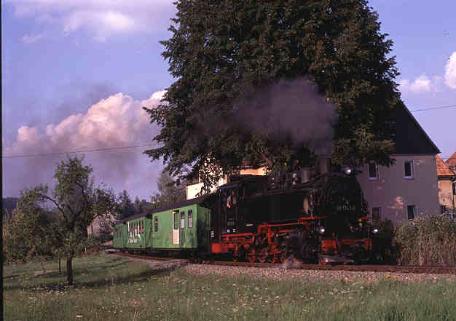
| Lineside scenes between Dippoldeswalde and Kipsdorf during July 2000 - currently this section remains closed |
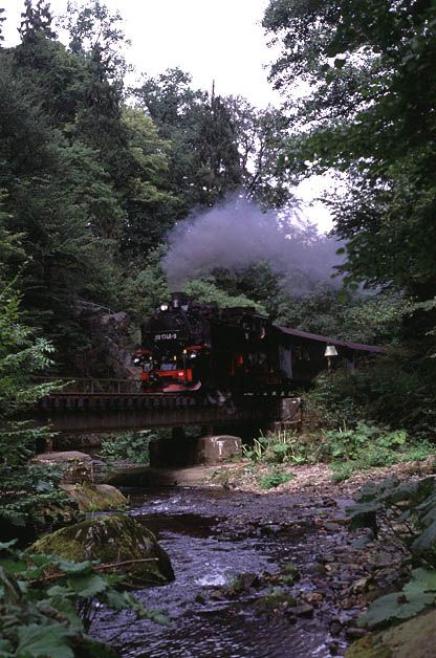
| RADEBEUL - RADEBURG A few miles north-west of Dresden is the Radebeul Ost - Radeburg line which is about 17km long and is also operated by 2-10-2T locomotives. This line currently sees seven workings to Moritzburg with three trains continuing on to Radeburg. Engines leave Radebeul smokebox first. The first few hundred yards runs alongside the main DB system before the line branches off and makes its way through the backstreets of Radebeul and then up through the gorge towards Moritzburg. Many tourists alight at Moritzburg to visit the spectacular castle before returning to Radebeul later in the day. The line itself carries on through fairly unspectacular scenery until it reaches Radeburg. Photographically the line is difficult as trains run from south to north for most of the way although there are good opportunities if you work hard enough! The Traditionsbahn-Radebeul are a private group who also operate an occasional tourist train on this line featuring a Saxon-Meyer 0-4-4-0 locomotive and traditional coaches, bringing an added interest although this is not strictly 'working steam'. For more datails go to the official web site |
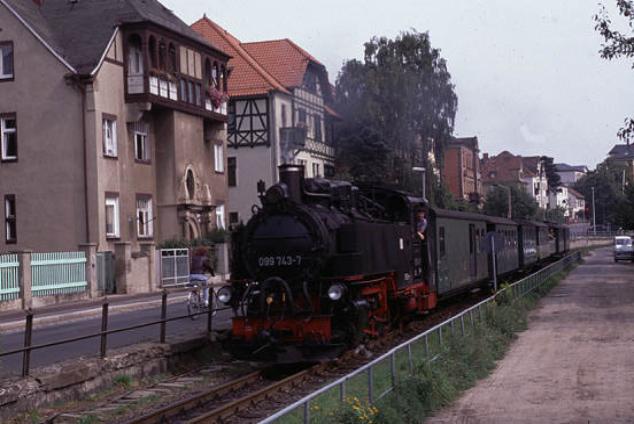
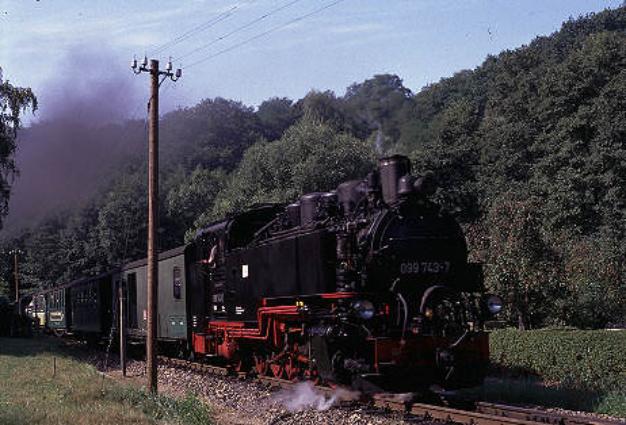
| 2-10-2T No.99-743 leaving Radebeul with the 14.25 train to Radeburg - almost 'street-running' |
| No.99-743 in the gorge between Radebeul and Friedewald - a difficult area in which to photograph due to the light |
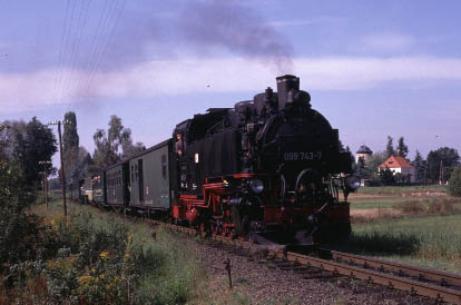
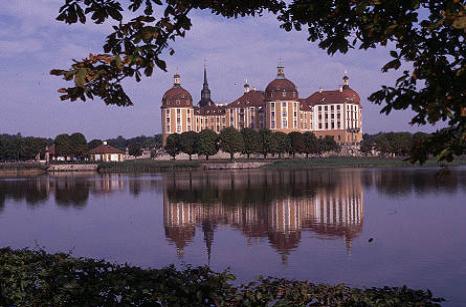
| No.99-743 coasting the last few hundred yards into the passing loop at Moritzburg station |
| Not a railway photograph but simply too beautiful to ignore - Moritzburg Castle |
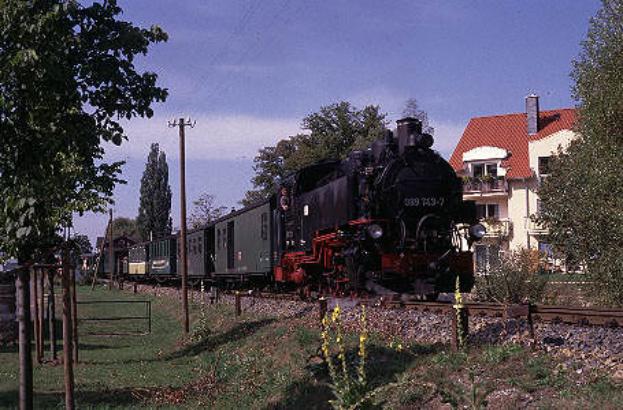
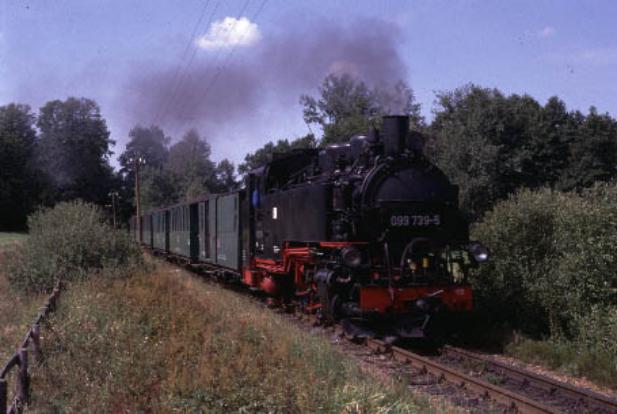
| No.99-743 makes a spirited departure from Moritzburg towards Radeburg in August 2000 |
| No.99-739 (built in 1928) stands in Moritzburg station awaiting the arrival of the Radeburg - Radebuel train heading in the opposite direction |
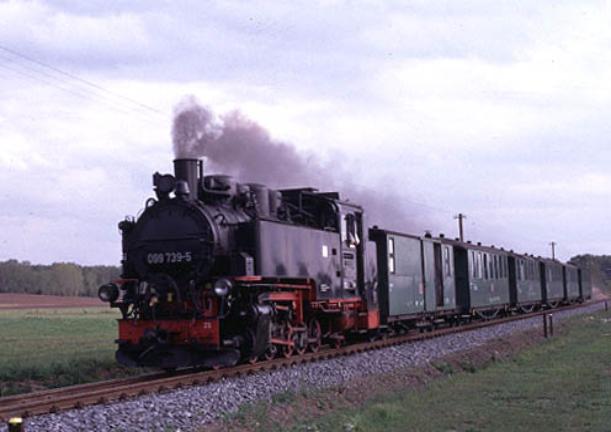
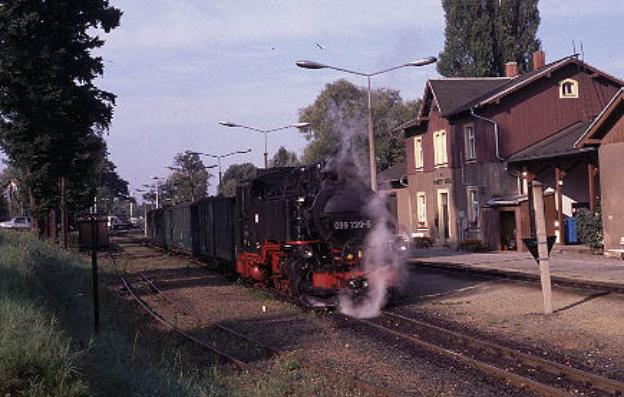
| 2-10-2T No.99-739 between Cunnertswalde and Barnsdorf with the 12.25 train from Radebeul |
| No.99-739 on a freshly ballasted section of line near Barbisdorf - signs of investment! |
CRANZAHL - OBERWIESENTHAL
The third line in the Saxony region is the 750mm gauge “Fichtelbergbahn� from Cranzahl to Oberwiesenthal - the highest
elevated town in Germany. Opened in 1897, the 17kilometre line operates throughout the year (thus qualifying it in my book as a
'working railway') The one hour journey starts in the town of Cranzahl and climbs through Unterneudorf and Neudorf before heading
into the forest of the Fichtelberg Mountains. The next station is Vierenstraße followed by the steepest climb of the journey up to
Kretscham-Rothensehma. The train then winds its way through unspoilt forest, still climbing, until arriving at Niederschlag. After
departing Niederschlag the line follows the border with the Czech Republic, via the towns of Hammerunterwiesenthal and
Unterwiesenthal before crossing the 23 metres high and 110 metres long Huttenbach viaduct to reach the resort of Oberwiesenthal.
Currently five locomotives, built between 1952 and 1956, are used on the line and overhauls are also undertaken of locomotives from
other 'museum railways' in the region. In line with its status as a 'working railway' the fare structure is very reasonable - a return trip
costs 12 Euro (as of December 2009) with a weekly (5 day) ticket costing just 30 Euro. A total of six workings in each direction is
maintained throughout the year. For further details go to the railways own website
The third line in the Saxony region is the 750mm gauge “Fichtelbergbahn� from Cranzahl to Oberwiesenthal - the highest
elevated town in Germany. Opened in 1897, the 17kilometre line operates throughout the year (thus qualifying it in my book as a
'working railway') The one hour journey starts in the town of Cranzahl and climbs through Unterneudorf and Neudorf before heading
into the forest of the Fichtelberg Mountains. The next station is Vierenstraße followed by the steepest climb of the journey up to
Kretscham-Rothensehma. The train then winds its way through unspoilt forest, still climbing, until arriving at Niederschlag. After
departing Niederschlag the line follows the border with the Czech Republic, via the towns of Hammerunterwiesenthal and
Unterwiesenthal before crossing the 23 metres high and 110 metres long Huttenbach viaduct to reach the resort of Oberwiesenthal.
Currently five locomotives, built between 1952 and 1956, are used on the line and overhauls are also undertaken of locomotives from
other 'museum railways' in the region. In line with its status as a 'working railway' the fare structure is very reasonable - a return trip
costs 12 Euro (as of December 2009) with a weekly (5 day) ticket costing just 30 Euro. A total of six workings in each direction is
maintained throughout the year. For further details go to the railways own website
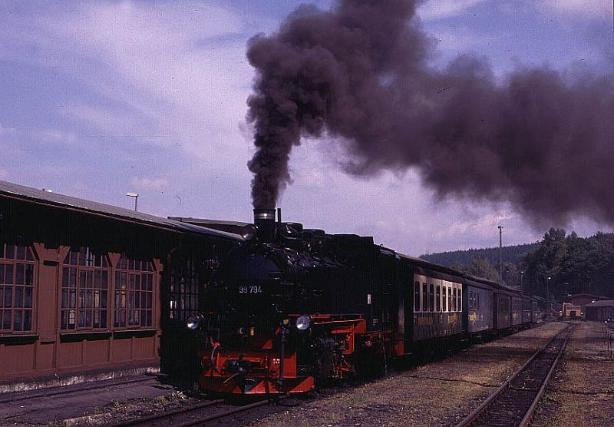
| The line starts adjacent to the DB station in Cranzahl. Here locomotive 99-794 is seen leaving for Oberwiesanthal with an afternoon train in August 2000 |
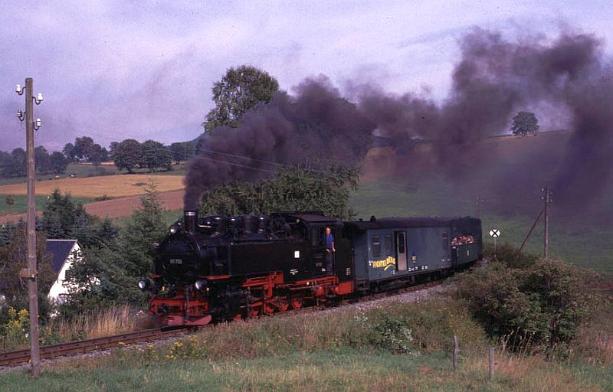
| Earlier in the day locomotive 99-786 gets its train underway shortly after leaving Cranzahl station |
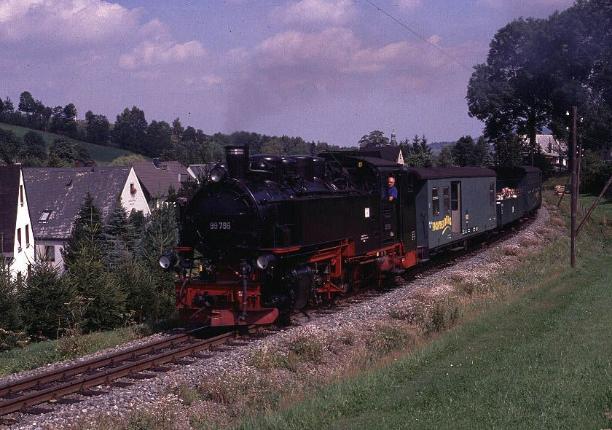
| Another shot of 99-786 between Cranzahl and Unterneudorf which is the second of nine stations on this line |
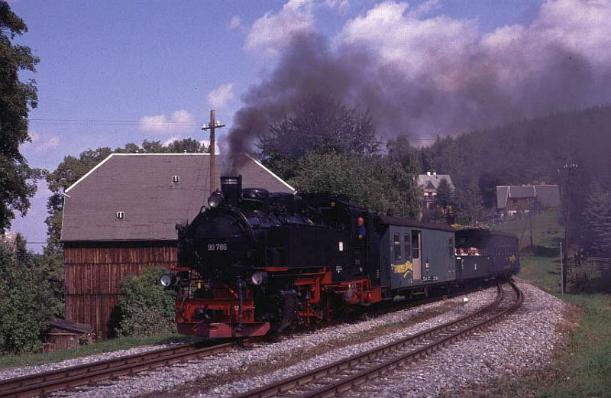
The first passing loop is at Neudorf and
99-786 is about to enter the station
heading for Oberwiesnthal. Without
turning facilities return workings are all
made bunker-first (August 2000)
99-786 is about to enter the station
heading for Oberwiesnthal. Without
turning facilities return workings are all
made bunker-first (August 2000)
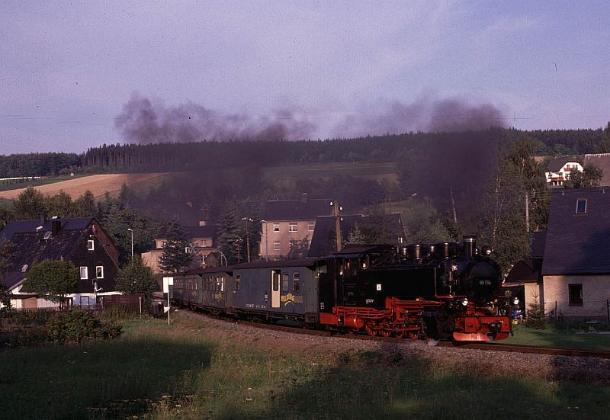
Catching the first rays of the morning
light, No.99-794 leaves Neudorf station.
This early morning train has no open
wagon which is a feature of summer trains
running later in the day
light, No.99-794 leaves Neudorf station.
This early morning train has no open
wagon which is a feature of summer trains
running later in the day
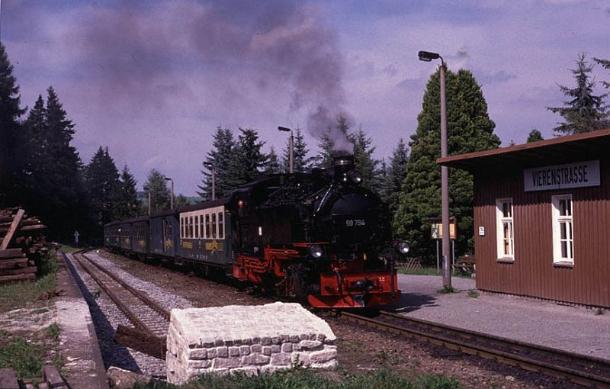
Given the low speeds and generous
stopping times it is possible to chase trains
up the line. Here No.99-794 is seen running
into Vierenstrasse, the next station up the
line.
stopping times it is possible to chase trains
up the line. Here No.99-794 is seen running
into Vierenstrasse, the next station up the
line.
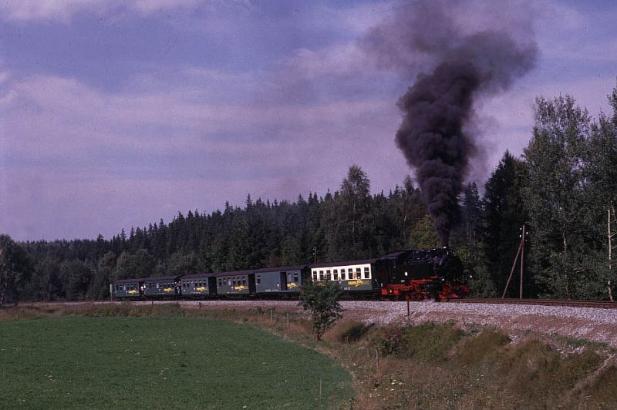
| The water stop at Kretscham provided sufficient time to request a little smoke when departing from the station - a request which was obviously granted by the friendly crew |
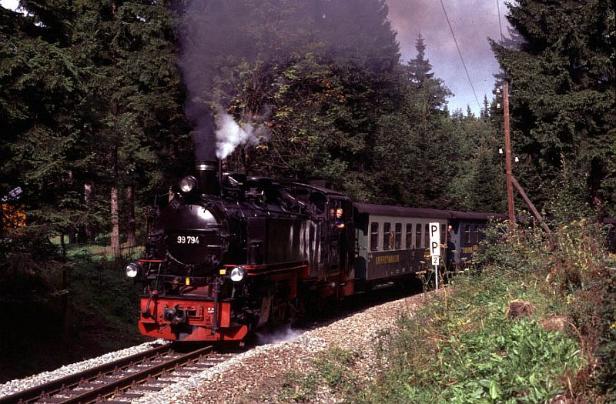
Deep in the forest something stirred .....
in this case No.99-794 again as it heads
towards Niederschlag.
in this case No.99-794 again as it heads
towards Niederschlag.
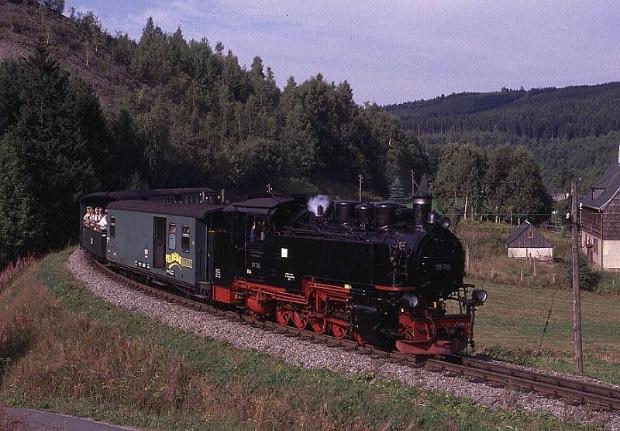
A different day - but the same
locomotive as it runs through the
countryside between Niederschlag and
Hammerunterwiesenthal
locomotive as it runs through the
countryside between Niederschlag and
Hammerunterwiesenthal
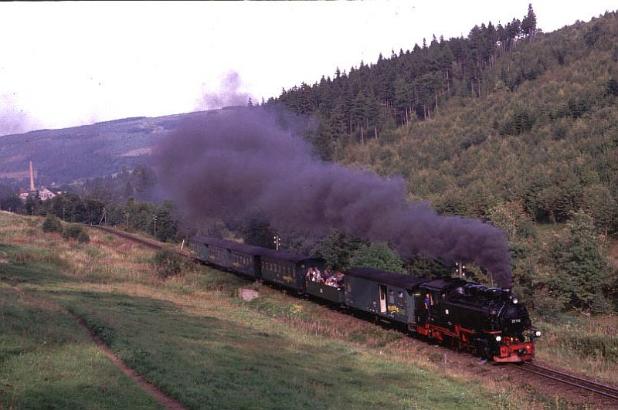
No.99-786 skirts alongside the Czech
border as it makes its way between the
stations at Hammerunterwiesenthal and
Unterwiesenthal
border as it makes its way between the
stations at Hammerunterwiesenthal and
Unterwiesenthal
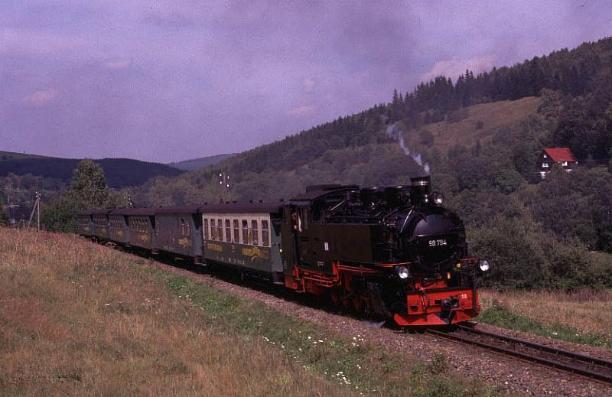
The house with the red roof is part of the
Czech Republic - the line in the foreground
with No.99-794 is just inside the German
border.f in the background is
Czech Republic - the line in the foreground
with No.99-794 is just inside the German
border.f in the background is
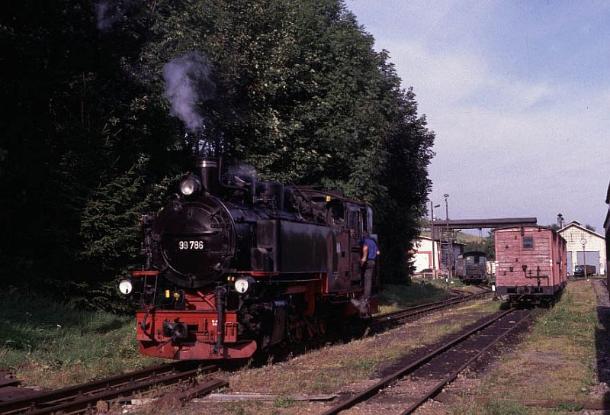
Just over seventeen kilometres and some
sixty minutes after departing from
Cranzahl, No.99-786 has reached
Oberwiesenthal and is now preparing to
run round its train prior to making the
return journey
sixty minutes after departing from
Cranzahl, No.99-786 has reached
Oberwiesenthal and is now preparing to
run round its train prior to making the
return journey
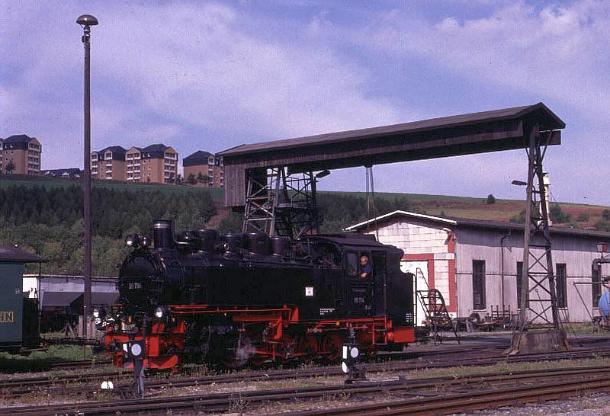
The workshop and overhead crane can
clearly be seen behind No.99-794 as it
stands in the yard at Oberwiesenthal
clearly be seen behind No.99-794 as it
stands in the yard at Oberwiesenthal